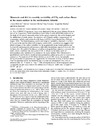Identificador persistente para citar o vincular este elemento:
https://accedacris.ulpgc.es/jspui/handle/10553/49810
| Campo DC | Valor | idioma |
|---|---|---|
| dc.contributor.author | Merlivat, Liliane | en_US |
| dc.contributor.author | González-Dávila, Melchor | en_US |
| dc.contributor.author | Caniaux, Guy | en_US |
| dc.contributor.author | Boutin, Jacqueline | en_US |
| dc.contributor.author | Reverdin, Gilles | en_US |
| dc.contributor.other | SANTANA CASIANO, JUANA MAGDALENA | - |
| dc.contributor.other | GONZALEZ DAVILA, MELCHOR | - |
| dc.contributor.other | Boutin, Jacqueline | - |
| dc.date.accessioned | 2018-11-24T10:54:38Z | - |
| dc.date.available | 2018-11-24T10:54:38Z | - |
| dc.date.issued | 2009 | en_US |
| dc.identifier.issn | 2169-9275 | en_US |
| dc.identifier.uri | https://accedacris.ulpgc.es/handle/10553/49810 | - |
| dc.description.abstract | Four CARIOCA Lagrangian buoys were deployed in the northeast Atlantic Ocean as part of the Programme Océan Multidisciplinaire Méso Echelle (POMME) dedicated to the study of the role of mesoscale eddies in biological production, the carbon budget, and the subduction of mode waters. An extensive set of hourly surface measurements of temperature, salinity, and carbon dioxide fugacity (fCO2) was collected from February to August 2001. The high‐frequency spatial and temporal variability observed in surface fCO2 and in the derived dissolved inorganic carbon (DIC) concentrations suggests that abrupt changes of the carbon variables are being generated along frontal patterns and filaments by submesoscale and mesoscale eddy‐eddy interactions, especially in winter. On the basis of a 1‐D model of the diurnal mixed layer along the buoy trajectory, we show that under certain conditions the diel cycle of DIC is driven by the daily cycle of photosynthesis and metabolic CO2 release at the ocean surface. This information is quantitatively used to derive in‐situ primary production, carbon gross, and net community production. The analysis of 107 observed diel cycles of DIC shows that episodic biological production processes are triggered by the mesoscale activity of surface eddies. Over the sampled period, the POMME area is a sink for atmospheric CO2 with an estimated flux of −4 mmol m−2 day−1. The calculated amount of anthropogenic carbon transported into the ocean interior by subduction of subpolar mode water is equal to 2.8 1013 gC yr−1. | en_US |
| dc.language | eng | en_US |
| dc.publisher | 2169-9275 | - |
| dc.relation.ispartof | Journal of geophysical research. Oceans | en_US |
| dc.source | Journal of Geophysical Research: Oceans [ISSN 2169-9275], v. 114 (C03010) | en_US |
| dc.subject | 251002 Oceanografía química | en_US |
| dc.subject.other | Oceanic carbon cycling | en_US |
| dc.subject.other | CO2 ocean uptake | en_US |
| dc.subject.other | Biogeosciences | en_US |
| dc.title | Mesoscale and diel to monthly variability of CO2 and carbon fluxes at the ocean surface in the northeastern Atlantic | en_US |
| dc.type | info:eu-repo/semantics/Article | en_US |
| dc.type | Article | en_US |
| dc.identifier.doi | 10.1029/2007JC004657 | |
| dc.identifier.scopus | 67649204458 | - |
| dc.identifier.isi | 000264440100001 | - |
| dcterms.isPartOf | Journal Of Geophysical Research-Oceans | - |
| dcterms.source | Journal Of Geophysical Research-Oceans[ISSN 2169-9275],v. 114 | - |
| dc.contributor.authorscopusid | 6603762071 | - |
| dc.contributor.authorscopusid | 6603931257 | - |
| dc.contributor.authorscopusid | 55986838800 | - |
| dc.contributor.authorscopusid | 7102994876 | - |
| dc.contributor.authorscopusid | 56264912000 | - |
| dc.identifier.issue | C03010 | - |
| dc.relation.volume | 114 | en_US |
| dc.investigacion | Ciencias | en_US |
| dc.type2 | Artículo | en_US |
| dc.contributor.daisngid | 371064 | - |
| dc.contributor.daisngid | 518149 | - |
| dc.contributor.daisngid | 552561 | - |
| dc.contributor.daisngid | 229413 | - |
| dc.contributor.daisngid | 199131 | - |
| dc.identifier.investigatorRID | K-5058-2014 | - |
| dc.identifier.investigatorRID | K-4958-2014 | - |
| dc.identifier.investigatorRID | M-2253-2016 | - |
| dc.utils.revision | Sí | en_US |
| dc.contributor.wosstandard | WOS:Merlivat, L | |
| dc.contributor.wosstandard | WOS:Davila, MG | |
| dc.contributor.wosstandard | WOS:Caniaux, G | |
| dc.contributor.wosstandard | WOS:Boutin, J | |
| dc.contributor.wosstandard | WOS:Reverdin, G | |
| dc.date.coverdate | Marzo 2009 | |
| dc.identifier.ulpgc | Sí | es |
| dc.description.jcr | 3,082 | |
| dc.description.jcrq | Q1 | |
| item.grantfulltext | open | - |
| item.fulltext | Con texto completo | - |
| crisitem.author.dept | GIR IOCAG: Química Marina | - |
| crisitem.author.dept | IU de Oceanografía y Cambio Global | - |
| crisitem.author.dept | Departamento de Química | - |
| crisitem.author.orcid | 0000-0003-3230-8985 | - |
| crisitem.author.parentorg | IU de Oceanografía y Cambio Global | - |
| crisitem.author.fullName | González Dávila, Melchor | - |
| Colección: | Artículos | |
Citas SCOPUSTM
18
actualizado el 08-jun-2025
Citas de WEB OF SCIENCETM
Citations
17
actualizado el 08-jun-2025
Visitas
71
actualizado el 10-ene-2026
Descargas
93
actualizado el 10-ene-2026
Google ScholarTM
Verifica
Altmetric
Comparte
Exporta metadatos
Los elementos en ULPGC accedaCRIS están protegidos por derechos de autor con todos los derechos reservados, a menos que se indique lo contrario.
